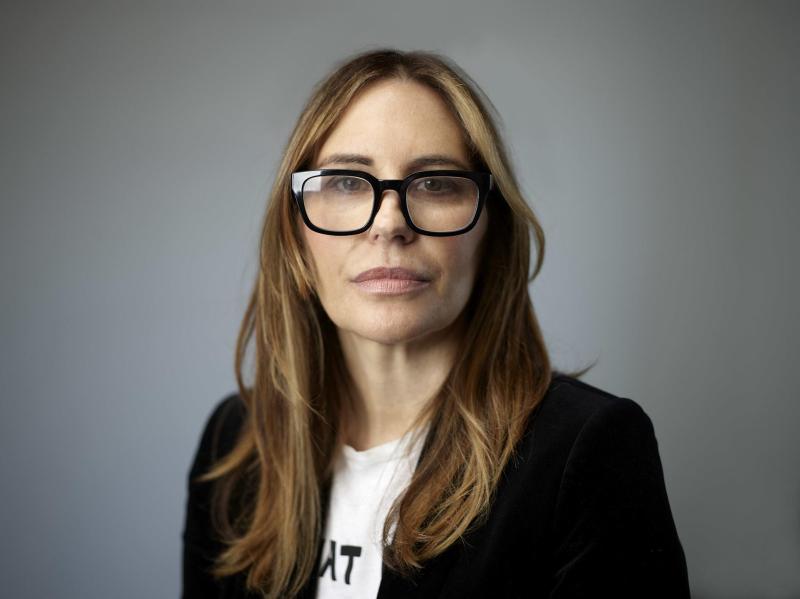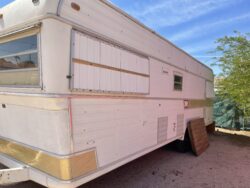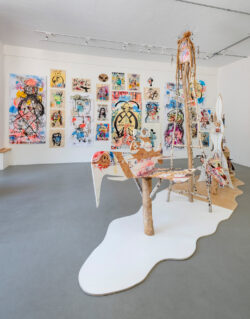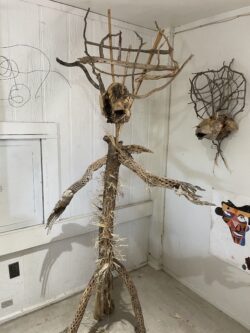PECHAKUCHA NOTES – Dr. Natasha Boas
On November 11, 2021, we were delighted with our second members’ PechaKucha. Four members were chosen through an open call to discuss their current and recent curatorial projects in the form of PechaKucha presentations: 20 slides are presented while a presenter has 20 seconds to comment on each slide, for a total presentation of 6 minutes and 40 seconds.
You can now follow the selection of these contributions in our blog section.
Brad Kahlhamer: “Swap Meet”
Making the Exhibition “Swap Meet” for Scottsdale Museum of Contemporary Art (SMoCA), forthcoming from February 26 to October 9, 2022.
Curator: Dr. Natasha Boas
[1. Photo credit Jennifer McCabe and courtesy of the artist 2020]
This is Brad Kahlhamer (born 1956) at the Mesa Arizona Swap Meet that inspired the exhibition for Scottsdale Museum of Contemporary Art (SMoCA). Kahlhamer is a New York and Arizona based artist whose work ranges from sculpture and painting to performance and music. He is a Native American artist who was “adopted out” as an infant by the Lutheran church into a German American family in Tucson, Arizona and later grew up in Wisconsin. Kahlhamer has no legally recognized Indigenous identity, his tribal birth place is unknown, the records are sealed and he carries no “card.”
[2. The Trailer, Photo credit: Jennifer McCabe and courtesy of the artist]
The social and cultural space of the Arizona desert swap meets reflects, models and fuels Kahlhamer’s recent artistic practice and preoccupations. This trailer, purchased at the Mesa, Apache Junction Swap Meet, will be the central element of the show, with a stage and proscenium built to host performances, storytelling and music. At the cross section of American cultures and his own culture as an artist, “Swap-Meet” becomes Kahlhamer’s meditation on a nomadic and intersectional contemporary condition.
This exhibition will engage a wide range of audiences. Kahlhamer has invited the young Navajo Country Music star Dirt Rhodes to anoint the stage on the opening night of “Swap Meet”. Performing his own form of country music, Navajo Nation musician Dirt Rhodes has been influenced by Indigenous rock and country bands from the past like Zuni Midnighters, The Nomads, and Sidney Poolheco.
Museumgoers will most likely feel they are part of Brad Kahlhamer’s gallery swap meet—a communal participatory space that activates thought and meaning. It is the curator and artist’s hope that the show will make people think more carefully about identity and nomadicity and what it means to be “American” today. “Swap Meet” is a space where all the different segments of the American story come together. Historically, the swap meet would be held at the meeting place of multiple territories; Kahlhamer’s swap meet is a transcultural space in which the artist celebrates his unknown indigenous ancestors. As Kahlhamer wrote to me recently, “It’s all about the Swap. The Swap as the dynamic, expansive, collective third space.” Like a museum, a gallery, or the art world itself, the swap meet is a site of exchange and experience, a gathering space for an affective community, like-minded strangers or friends who seek out a place of meaning, belonging or simply survival.
[3. Brad Kahlhamer , Bowery Nation Hawk + Eagle (detail), 2018. Wood, rope, acrylic, pow wow bells and jingle, 12 x 4 x 16 feet. Exhibited at Bockley Gallery and image courtesy of the artist.]
Bowery Nation + Hawk + Eagle, Bockley, Kahlhamer’s Tribe—Bowery Nation—Kahlhamer has created his own Nations to belong to. He has spoken of Bowery Nation as an “alternative tribe” since he has no official tribal affiliation and it is his “third space,” and the fact that the majority of the work’s individual elements were born on New York’s Lower East Side (the part of the city with the most extensive history of immigration) adds to his affiliation.
[4. Nomadic Studio Notebooks. Photo credit: Natasha Boas]
“Swap Meet” suggests the possibility of transactions as well as transnationalities, of repurposing and recycling, of movement and borderlessness. The conversations and platforms made possible by Kahlhamer’s work have yet to be fully explored—contemporary Indigenous art remains tucked in the shadows and the corners of the art world, even if he is one of the more visible Native-American artists to occupy this space.
Kahlhamer calls himself “A post-Smithsonian delinquent.” He questions notions of authenticity and representation within the very specific discourse of Native American art. These matters become all the more complex and urgent in view of the concept of originality or of the primordial as established by many Native American people today. Adopting the position of delinquency within these fields of discourse is a simultaneously precarious act—offering oneself as a vulnerable target—which, however, also provides the potential for innovation, for a discursive handling of identity, cultural representation and self-reflexion.
Kahlhamer began his Nomadic Studio sketchbooks in the early 1980s; by 2021, he has made close to one hundred volumes in total. These sketchbooks include drawings from his many trips throughout the US and Europe and offer a direct reference to the historic Indian Ledgers, which were created in the late nineteenth century when the tribes of the Great Plains were relocated by the US government. Unable to record events on animal hides using natural pigments as was tradition, and confined to a reservation or faced with imprisonment, these Great Plains Native Americans relied on materials they had available to them: namely, ledger books they had found, and pencils discarded or bartered from traders or government agents. Often already full of numbers and lists, these ledgers were used to record immediate, present traumas as well as older stories and past achievements. Often referred to as a “transitional” art form, Kahlhamer sees these Great Plains Indian images as “the original American cartoon chronicling a dark history.” Originally casual, accessible, and makeshift, Kahlhamer’s ledgers have paradoxically become his lifework—the constant in his otherwise peripatetic artistic practice.
[5. Zombie Botanicals, photo credit: Jennifer McCabe]
To these elements, the artist adds a new series, his Zombie Botanicals—sculptural trophy heads and walking figures made out of decayed cactus parts he has found in the nearby Superstition Mountains. These eerie, otherworldly sculptures speak to the denatured, serving at once as protectors or talismans and existing as half-dead creatures caught between worlds. Zombies are dead people who are ambulatory—they are revenants. These Zombie Botanicals have joined the ranks of Kahlhamer’s “family” or “squad,” like his Katsina Dolls (which also now number close to one-hundred), made and multiplied in exhibitions over three decades; and his collection of taxidermy animals that surround him in both his Arizona and New York studios.
He explains: “These Zombie Botanicals are a sort of deception. Like me, they’re tribally ambiguous. They are like katsina dolls of the Hopi tribe which are thought to embody and channel spiritual power. There’s this constant tumbling of a figure, from one iteration to the next.” The dried-out saguaro cactus parts, like re-membered bodies, convene and converge, insufflated with life and meaning in Kahlhamer’s world.
*Dr. Natasha Boas. Photo credit: Robert Divers Herrick







